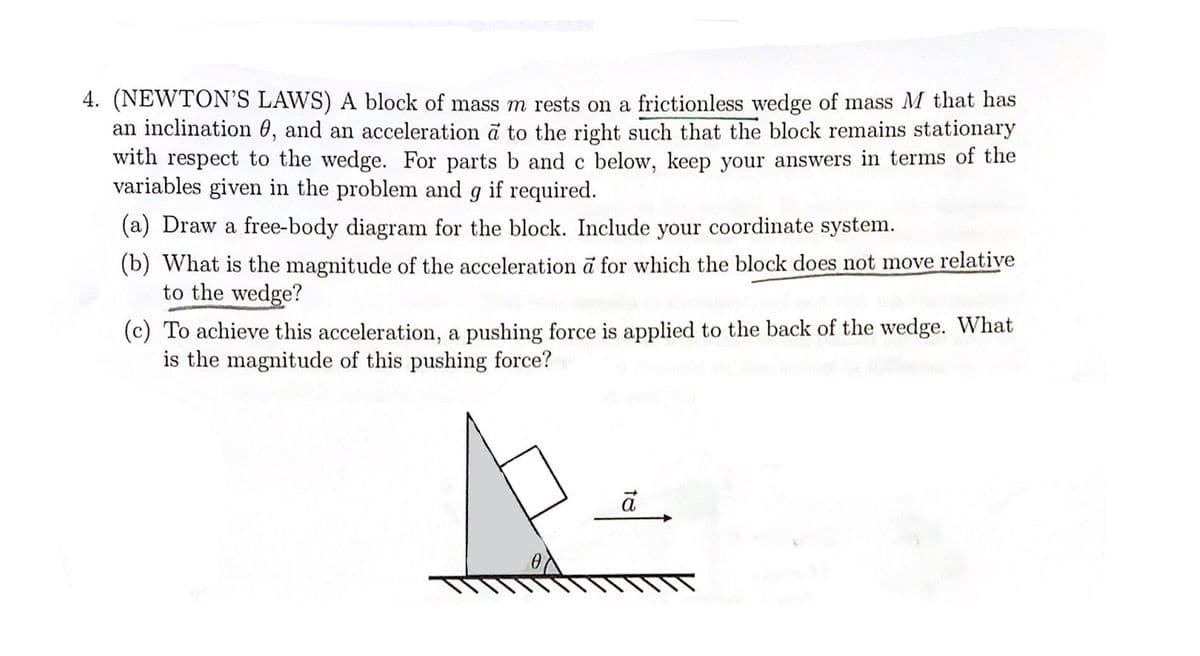(NEWTON'S LAWS) A block of mass m rests on a frictionless wedge of mass M that has an inclination 0, and an acceleration a to the right such that the block remains stationary with respect to the wedge. For parts b and c below, keep your answers in terms of the variables given in the problem and g if required. (a) Draw a free-body diagram for the block. Include your coordinate system. (b) What is the magnitude of the acceleration a for which the block does not move relative to the wedge? (c) To achieve this acceleration, a pushing force is applied to the back of the wedge. What is the magnitude of this pushing force?
(NEWTON'S LAWS) A block of mass m rests on a frictionless wedge of mass M that has an inclination 0, and an acceleration a to the right such that the block remains stationary with respect to the wedge. For parts b and c below, keep your answers in terms of the variables given in the problem and g if required. (a) Draw a free-body diagram for the block. Include your coordinate system. (b) What is the magnitude of the acceleration a for which the block does not move relative to the wedge? (c) To achieve this acceleration, a pushing force is applied to the back of the wedge. What is the magnitude of this pushing force?
University Physics Volume 1
18th Edition
ISBN:9781938168277
Author:William Moebs, Samuel J. Ling, Jeff Sanny
Publisher:William Moebs, Samuel J. Ling, Jeff Sanny
Chapter6: Applications Of Newton's Laws
Section: Chapter Questions
Problem 135CP: A boater and motor boat ate at rest on a lake. Together, they have mass 200.0 kg. If the thrust of...
Related questions
Question
Please include explanations and work for the problems. Please write it out to make it easy to understand.

Transcribed Image Text:4. (NEWTON'S LAWS) A block of mass m rests on a frictionless wedge of mass M that has
an inclination, and an acceleration a to the right such that the block remains stationary
with respect to the wedge. For parts b and c below, keep your answers in terms of the
variables given in the problem and g if required.
(a) Draw a free-body diagram for the block. Include your coordinate system.
(b) What is the magnitude of the acceleration à for which the block does not move relative
to the wedge?
(c) To achieve this acceleration, a pushing force is applied to the back of the wedge. What
is the magnitude of this pushing force?
ā
Expert Solution
This question has been solved!
Explore an expertly crafted, step-by-step solution for a thorough understanding of key concepts.
Step by step
Solved in 2 steps with 2 images

Knowledge Booster
Learn more about
Need a deep-dive on the concept behind this application? Look no further. Learn more about this topic, physics and related others by exploring similar questions and additional content below.Recommended textbooks for you

University Physics Volume 1
Physics
ISBN:
9781938168277
Author:
William Moebs, Samuel J. Ling, Jeff Sanny
Publisher:
OpenStax - Rice University

Principles of Physics: A Calculus-Based Text
Physics
ISBN:
9781133104261
Author:
Raymond A. Serway, John W. Jewett
Publisher:
Cengage Learning

University Physics Volume 1
Physics
ISBN:
9781938168277
Author:
William Moebs, Samuel J. Ling, Jeff Sanny
Publisher:
OpenStax - Rice University

Principles of Physics: A Calculus-Based Text
Physics
ISBN:
9781133104261
Author:
Raymond A. Serway, John W. Jewett
Publisher:
Cengage Learning